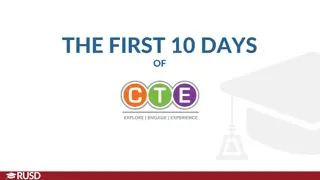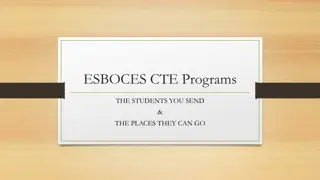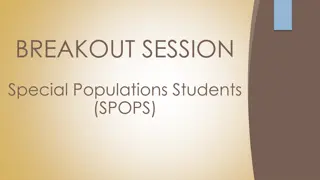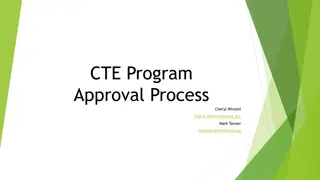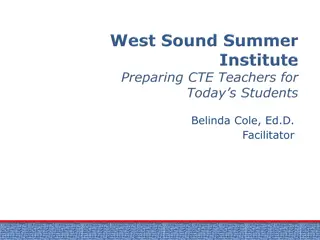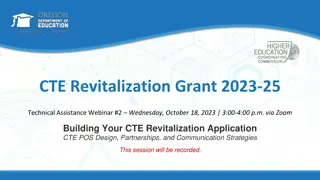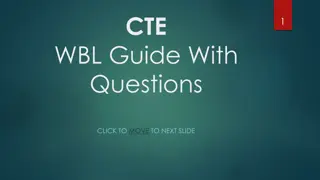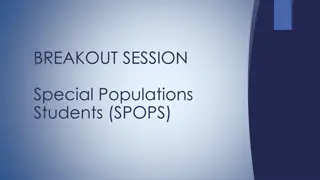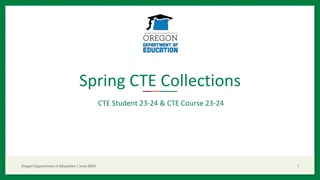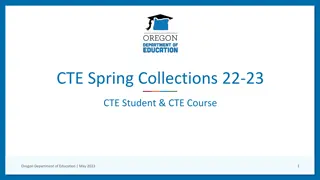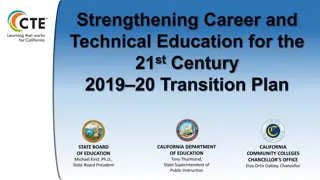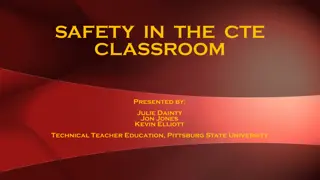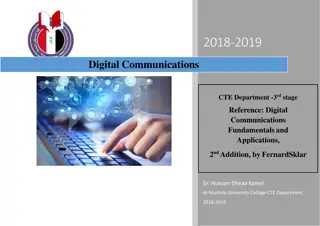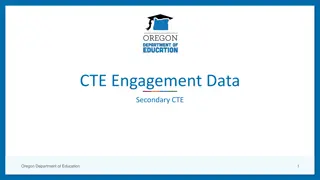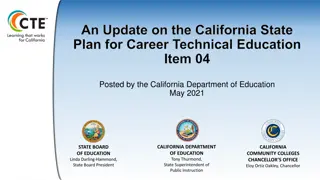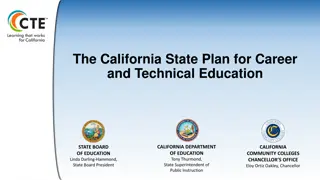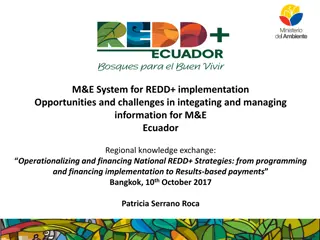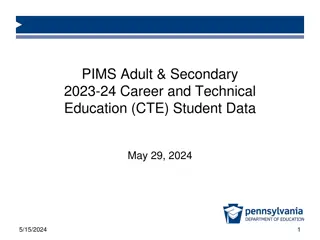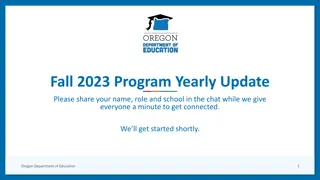California State Plan for CTE Implementation Overview
California State Plan for Career and Technical Education (CTE) outlines key drivers, strategies for regional implementation, and engagement with stakeholders. It emphasizes aligning efforts to meet future workforce needs, enhancing equity, and leveraging funding strategically.
Download Presentation

Please find below an Image/Link to download the presentation.
The content on the website is provided AS IS for your information and personal use only. It may not be sold, licensed, or shared on other websites without obtaining consent from the author.If you encounter any issues during the download, it is possible that the publisher has removed the file from their server.
You are allowed to download the files provided on this website for personal or commercial use, subject to the condition that they are used lawfully. All files are the property of their respective owners.
The content on the website is provided AS IS for your information and personal use only. It may not be sold, licensed, or shared on other websites without obtaining consent from the author.
E N D
Presentation Transcript
Inclusion of Persons with Disabilities in Shelter and Settlements Programming Global Shelter Cluster ShelterCluster.org Coordinating Humanitarian Shelter September 2020 Working Group Call
Agenda Update on planned field consultancy in CXB Overview of the Elrha Gap Analysis on the Inclusion of people with Disability and Older People in Humanitarian Response Accessible IECS update on the PSB working group protocol and the IEC materials compendium process Shelter Projects + learning from a case study Takeaways from the Shelter & Health learning day AoB and Q&A
Inclusion of Persons with Disabilities in Shelter and Settlements Programming Field Consultancy: Cox s Bazar Update Agenda Inception phase completed but on hold due to COVID-19 Consultants: Caroline Dewast, Shirin Kiani, David Dalgado Revised timeframe of visit (dependent on COVID-19 further disruption) February 2021 for 3 weeks Current initiatives which may impact REACH work. Methodology Global Shelter Cluster ShelterCluster.org Coordinating Humanitarian Shelter
Methodology Outline: 1. Identification of key questions 2. Context analysis & Literature review 3. Identification of stakeholders 4. Disability Inclusion Assessment with practitioners 5. Risk mapping; and enablers and barriers mapping exploration through people with disabilities lived experience 6. Validation discussions /workshop 7. Participatory workshop with practitioners
Extract of list of questions (Circa. 30 question, organised around the Programme Cycle).
Stakeholder Mapping In relation to this assignment to investigate disability inclusion in shelter and settlement programming the following are important stakeholders: Shelter/NFI Sector Coordination Team* Shelter/NFI Sector agencies particularly the Shelter TWiG attending Shelter Staff* Site Management & Site Development Coordination Team* Site Management & Site Development agencies* Site Maintenance and Engineering Project (SMEP) representative* Age and Disability Working Group lead and key agencies* Protection Working Group* PSEA Network under the ISCG Gender Hub* under the ISCG Gender in Humanitarian Action (GIHA) under UN Women WaSH Sector Coordination Team* Health Sector Coordination Team Communications with Communities working group* IOM and UNHCR staff who are included in the above groups but play a particular crucial role because of their division of Area of Responsibility in the camps.* Red Cross Red Crescent (IFRC*, BDRCS) who may be included in the above groups but may not be as involved in the Inter-Agency coordination activities and structures. Cyclone Preparedness Programme (CPP) staff in Cox s Bazaar who may be involved in the mega-camp CPP initiatives. UNICEF* particularly with respect to Child Protection Persons with disabilities* Persons with disabilities caregivers and family* Disabled Peoples Organisations, DPOs Disability-specific humanitarian agencies* Community leaders* & religious leaders* Refugee Relief and Repatriation Commission (RRRC) and Camp-in-Charge staff* Bangladesh Government Armed Forces involved in camp coordination Needs and Population Monitoring (NPM)*, UNHCR Registration staff* and REACH* Donors (such as DFID, ECHO and others)* * Essential, whereas those without an asterisk are only where time allows Fufils a similar function to IOMs Displacement Tracking Matrix in other countries/contexts.
Consultations with persons with disabilities 1) Leaders & vocal persons with disabilities with any type of impairment 2) Adults with visual and physical & mobility impairments 3) Adults with hearing impairments and their caregivers (where appropriate) may be solely through KIIs given that FGDs may be difficult, especially if different communication methods are required. 4) Adults with mental health impairments and their caregivers (where appropriate) it is recognised that it can be hard to identify and interview these adults and it is thought likely KIIs will be needed here and connections (with consent) made through agencies providing psycho-social support/mental health support will be required. 5) Adults with intellectual impairments it is thought likely KIIs will be required here. 6) Children with visual impairments and their caregivers could potentially be undertaken with KIIs with caregiver and potentially children. Note FGDs will be split by gender and age where appropriate. Recognised intersectionality disability, age, class/caste, etc.
AoB and sharing Key Messages on applying IASC Guidelines on Disability in the COVID-19 Response - Provides an overview of the factors that may put persons with disabilities at heightened risk in the COVID-19 pandemic and response in humanitarian settings Open call for case studies for Forced Migration review related to Mental Health and Psychosocial Support - Abstracts due 19 October 2020 Global Shelter Cluster meetings coming up in October (online) For more information and to contribute contact: disability.inclusion@sheltercluster.org


